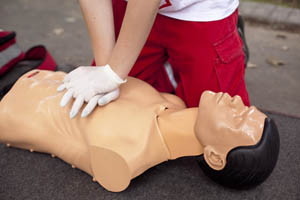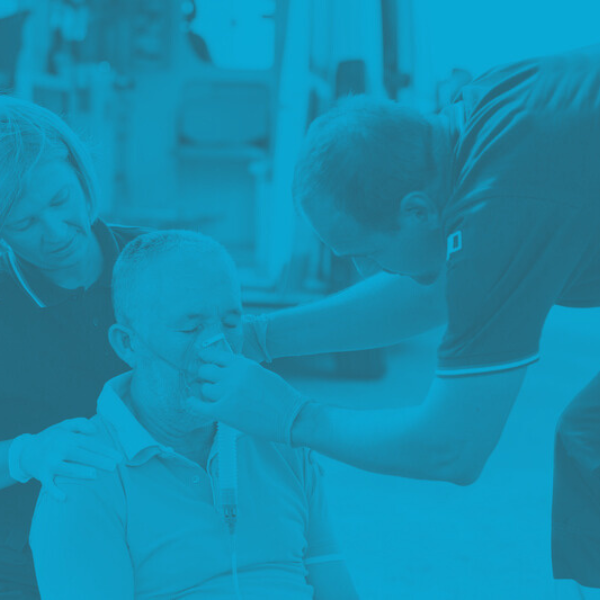The Positive Effects Of BLS For Healthcare Providers
The Positive Effects Of BLS For Healthcare Providers

by Greta Kviklyte
Life Saver, AMC
Co-authored by Kim Murray, RN, M.S.
posted on Mar 1, 2019, at 9:00 am
In-hospital cardiac arrest (IHCA) and out-of-hospital cardiac arrest (OHCA) mortality rates are staggering. According to the ScienceDirect.com, only 12 percent of those that suffer OHCA survive. However, those that suffer IHCA have a survival rate of 24.8 percent. The distinction is the immediate responsiveness of healthcare professionals. Therefore, BLS for healthcare professionals is essential to doubling the survival chances of those in need of care.
We offer Online CPR and BLS Certification
The positive effects of knowing how to respond to cardiac arrest permeate the healthcare industry; recognizing them can be more difficult. The benefits go further than obvious improvements to personal skill set. In fact, healthcare professionals should consider these top ways proper training can impact their workplace, personal careers, and patients.

BLS for Healthcare Providers Improves the Attitude of Staff
Completing a BLS course can have a drastic effect on employee morale and attitude. As explained by the National Library of Medicine (NLM), a study of the perception and attitude toward CPR and BLS found a significant increase in positive attitudes among those that complete a course. The degree of positivity was highest among those that recently completed a course.
The study used a questionnaire to assess perception of CPR in the healthcare facility prior to and after attending training. Approximately 53 percent of participants expressed positive attitudes before completing a course. That statistic rose to 64.8 percent upon completion. Moreover, the number of total CPR and BLS courses taken over multiple years affects perception as well.
Although positive attitudes toward life-saving measures may seem unrelated to employee morale, it is important to remember healthcare professionals work in a high-stress environment. Mistakes in providing care during such crises take an emotional toll. Recurrence of errors can lead to disciplinary action, further increasing the risk of burnout. As explained by the Agency for Healthcare Research and Quality, the typical burnout rate among healthcare professionals rose 9 percent between 2012 and 2015.
The problem with burnout goes back to its impact on patients. Healthcare professionals experiencing burnout become detached from their work. Negative attitudes develop, and patient safety falls by the wayside. Negative emotions add fuel and hostility to the workplace, creating a feedback loop that increases the prevalence of burnout. Making a slight change in attitude, especially involving emergency care and response, reinvigorates passion and commitment to help others. Thus, BLS may lead to lower burnout rates and improvements to patient care and treatment outcomes.
Proper Education and Application of Skills Enhance Student Learning
 The quality of education among healthcare professionals determines success in treating patients. According to the NLM, nursing students that complete an online course develop their professional and personal skills in tandem. Online students must take the initiative to complete course modules and study independently. This helps prepare nursing students to make life-altering decisions in the clinical setting. Furthermore, proper education builds the confidence necessary to apply skills under pressure.
The quality of education among healthcare professionals determines success in treating patients. According to the NLM, nursing students that complete an online course develop their professional and personal skills in tandem. Online students must take the initiative to complete course modules and study independently. This helps prepare nursing students to make life-altering decisions in the clinical setting. Furthermore, proper education builds the confidence necessary to apply skills under pressure.
Although the study indicates a comparable level of knowledge retention between online and in-person courses, individual facilities may have different requirements. Students may need to complete a “Mock Code Blue” to test their skills in the workplace. In fact, the ongoing application of skills in a simulated environment, including both online and in-person training, is linked to an increase in confidence and ability to respond.
Training Allows for Professional and Personal Growth in Underdeveloped Areas
Another key effect of completing BLS training exists in underdeveloped areas. Underdeveloped areas include locations with limited access to emergency services, other countries and isolated areas. For example, healthcare professionals working overseas can leverage their skills to bring healthcare to new regions. The effect is not limited to medical professionals; even dental care professionals that complete a course can have a drastic impact on quality of life and access to healthcare. A recent study of Nigerian Dental Students, asserts the Nigerian Postgraduate Medical Journal (NPMJ), found understanding basic life-saving skills to be minimal, participants were only able to score 40 percent on a test to determine BLS and CPR skill set. Upon completion of a course, student averages rose significantly with 88 percent answering at least seven of 10 questions correctly.
The study notes areas with limited development may have a higher risk of mortality following a cardiovascular event, including arrest. Even though dental students may not be in the position to treat severe medical illnesses, each person that completes a thorough course on emergency response serves to reduce the risk of mortality. In other words, encouraging all healthcare professionals to complete a course, including those working outside of the traditional medical sphere, should lower mortality rates in underdeveloped areas.
Knowing How to Respond Leads to the Creation and Use of “Help Me” Apps
As explained by the Journal of Emergency Medical Services (JEMS), the way people with respond has evolved due to technology. Government and non-profit organizations created mobile apps to further reduce the amount of time between arrest and receiving care outside of the hospital setting. These “Help Me” apps function by connecting BLS-certified citizens with those in need of assistance. They do not replace the role of EMS; they provide a way to augment first responders and improve patient outcomes. It all derives from situational awareness.
For example, John Smith is walking down the road when he collapses. Passersby stop to render aid, but they do not know how to perform CPR. One person uses an app to notify users in the vicinity of the emergency. Those with training receive an alert. Different apps exist, geared toward civilians or healthcare professionals.
The great irony of these systems goes back to a simple problem; family members and friends may be reluctant to provide CPR. Any time lost due to apprehension will increase the risk of mortality, as well as long-term injuries. However, bringing someone with the right training into the equation ensures someone can step in and provide care until EMS arrives.
These systems function through the computer-aided dispatch (CAD) system, which is also the system used to dispatch emergency responders. Both emergency responders and app users are notified at the same time, and in high-traffic or rural areas, this can cut response time significantly. Ultimately, both metropolitan, rural and under-developed areas benefit from the use of this technology, which is expected to become widely available in the next two years.
Better Understanding and Responsiveness Contributes to Better Patient Outcomes
Patients that receive high-quality CPR and BLS have better treatment outcomes. According to NCBI.NLM.NIH.gov, high-quality CPR refers to the proper compression-to-breath ratio, adequate compression depth, allowing for chest recoil and checking for a pulse. Although the study analyzed the compression rate in relation to a return of spontaneous circulation (ROSC), the results indicate better compressions have a higher survival rate.
In addition, the prior AHA recommendations called for a compression rate of 100 per minute across all age groups. However, the AHA changed the recommendation slightly, advising of at least 100 compressions per minute. As a result, BLS for healthcare providers now teaches students to perform 100-120 compressions per minute. The goal is to keep compression speed up to give patients proper perfusion of the organs and encourage ROSC.
Knowing how to respond to someone in cardiac or respiratory arrest is applicable outside of the care setting as well. Healthcare professionals have a professional duty to render aid to those that suffer arrest outside of the typical facility, and the ability to act immediately is crucial to ROSC. In fact, the real effect can be seen by reviewing the survival rates of IHCA versus OHCA. In cases of IHCA, performing CPR and BLS is a given. However, those suffering OHCA have a greater risk of not receiving care immediately. A mere 46 percent of those that suffer OHCA receive bystander CPR, asserts CPR.Heart.Org. Consequently, the survival rate of OHCA is much less than those suffering IHCA.
Of course, administration of advanced measures, including medications to treat the reversible causes of arrest, is an integral part of increasing survival chances following IHCA. That does not negate the importance of providing BLS and CPR until EMS arrives. In other words, those that have completed the proper training for responding to IHCA can apply those skills outside of the facility and save lives, and the life saved could be a stranger, a friend, your mother, father, child or even your co-worker.
High-Quality Education Augments the Prowess of Your Resume/CV
Improvements to your resume have the power to affect your ability to find and secure employment. In healthcare, your resume must meet the minimum requirements for hiring managers to even begin the interview process. Completing an online BLS for healthcare professionals course helps your resume or Curriculum Vitae (CV) stand apart, especially for those new to the field. In fact, some ways BLS for healthcare professionals impacts your resume include:
- It demonstrates your willingness to complete extra training to improve your skills. The obvious benefit to your resume of completing a BLS course is its impact on your professional and personal development. Since you are willing to maintain outside certifications to expand your career options, it demonstrates your willingness to.
- Keeping up with life-saving certifications is a prerequisite for direct-care positions. Some employers may not even consider hiring an individual that does not already have appropriate certifications prior to applying.
- BLS and CPR training are valuable skills for all industries, including support services for the healthcare industry. Although BLS is a core certification for healthcare professionals, completing training is useful for any industry, especially those involving childcare and services to the public.
- Immediate recognition of certification streamlines hiring decisions/processes. Healthcare managers that see skills and certificates listed on your application are more likely to contact you and schedule an interview. Even if certification is provided by the facility for employees that do not already have it, getting your certification in advance increases the attractiveness of your resume.
- Life-saving skills open the door to specific areas of healthcare. Completing a BLS course is much more than just a prerequisite for certain floors. Listing your past and current certifications can help managers choose an applicant for large facilities, especially hospitals. For instance, those with BLS may work in supportive roles, but those with advanced training may work in intensive care units (ICUs) or acute care facilities too.
Ultimately, the skills listed on your resume, proven with a certificate of completion, help you find and keep the healthcare position you want. Moreover, it eliminates the uncertainty and confusion in maintaining your credentials and providing documentation to employers.
Take Advantage of the Positive Effects of BLS Training
The positive effects of BLS training for healthcare professionals are too great to ignore. Completing a proper training course prepares you to respond to both IHCA and OHCA. From the effects on better patient outcomes to professional development, BLS is the best and easiest way to save more lives.
Put these effects to work in your workplace and life by enrolling in a life-saving skills course now. Has your facility seen a reduction in adverse patient outcomes following comprehensive training requirements for BLS? Share your experiences or thoughts along with this article to social media now.



